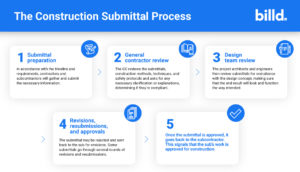Table of Contents
What Is a Construction Submittal?
A submittal is a general term for written information that must be supplied by contractors or subcontractors to the engineers, architects, consultants, general contractor, or other stakeholders on a project. This information acts as proof that the contractor or sub is complying with the construction plans.
Based on the submittals, the general contractor, engineers, and architects can check the quality of materials, verify that the subcontractors are adhering to the design concept, and more effectively keep the project on time and within budget. If materials and equipment aren’t approved beforehand, it can be significantly more time consuming and costly to fix issues once construction has started.
What to Include in a Submittal
Before the project begins, every piece of equipment and type of material must be submitted, reviewed, and approved. This means that submittals can be extensive — some including thousands of different items. In general, submittals may include:
- Shop drawings that illustrate specifications and dimensions for project components such as windows, appliances, millwork, trusses, and more.
- Color charts
- Finish selections
- Material data
- Product samples
- Product cut sheets that identify the manufacturer, specifications, and model number
- Adherence to the Buy American Act if applicable
Why Construction Submittals Are Important
Submittals can benefit construction projects in several ways:
- Keep projects on time and within budget: Approving materials and equipment in advance can prevent costly issues down the line. Without appropriate submittals, wrong or unapproved materials may be fabricated and delivered. Making adjustments at that point can significantly set a project back in terms of both budget and timeline.
- Ensure the safety of construction workers and future building occupants: With appropriate submittals, the general contractor and other stakeholders can review and verify subcontractors’ methods, techniques, procedures, and safety measures. The general contractor can identify any non-compliant items, which provides an added layer of protection both during the construction process and once the building is complete and operational.
- Adhere to design plans and specifications: Because submittals are so detailed, they provide the design team with insight into materials, colors, and other design aspects. The design team can then ensure that the materials, colors, and finishes are appropriate to meet the design concept and specifications.
Types of Construction Submittals
There are many different types of submittals, based on the project standards that the subcontractors are expected to follow. Here are a few of the most common types:
- Product samples: Samples are examples of the actual product that will be used in the project, such as paint or flooring. Seeing the actual product can help architects and designers make sure that the materials will fulfill the design specifications.
- Shop drawings: Blueprints and diagrams are types of shop drawings — drawings that illustrate prefabricated components to be completed off-site. For instance structural steel components, precast concrete structures, or engineered joists will require shop drawings.
- As Built Drawings: These are also known as red-line drawings, or record drawings. These are a revised set of drawings submitted by a contractor to the designer upon completion of a project. As built drawings allow a contractor, engineer/designer, and owner to be on the same page about the designed project plans, and how a project was actually constructed.
- Material data: Material or product data usually contains details, such as dimensions, characteristics, warranty information, and more, about the materials that will be used in the project. On certain types of government projects you may also be required to provide proof that you are adhering to the Buy American Act. This information helps stakeholders decide if the material will work appropriately within the design of the project.
How Does the Submittal Approval Process Work?

Considering that submittals are required for every facet of a project, the submittal process can — understandably — be long. Generally, the submittal approval process involves the following steps:
Step 1: Submittal preparation
First, the general contractor will identify items that require submittals. Then, the general contractor and other project stakeholders will collaborate to create the submittal timeline, ensuring that each reviewer has adequate time to assess and approve the submittals. They will also establish submittal requirements and delivery methods.
In accordance with the timeline and requirements, contractors and subcontractors will gather and submit the necessary information.
Step 2: General contractor review
The GC reviews the submittals and asks for any necessary clarification or explanations (e.g., if the submittal deviates from the original construction plans). The GC also reviews the construction methods, techniques, and safety protocols. Once the GC determines that the submittals are compliant, he sends them to the design team.
Step 3: Design team review
At this point, the project architects and engineers have the opportunity to review submittals. The design team reviews for compliance with the design concept, making sure that the end result will look and function the way intended.
Step 4: Revisions, resubmissions, and approvals
During the review process, the submittal may be rejected and sent back to the sub for revisions. Some submittals go through several rounds of revisions and resubmissions. Once the submittal is approved, it goes back to the subcontractor. This signals that the sub’s work is approved for construction.
Construction Submittal Best Practices
When preparing and sending submittals, subs should strive to adhere to the following best practices:
- Double check that your submittal is thorough and compliant: To avoid potential delays, review your submittal thoroughly before sending it to the GC.
- Submit on time: Adhere to the predetermined submittal timeline to keep the construction project on track.
- Submit a comprehensive, complete package: To streamline the review process, it’s best for subs to submit all materials and documents as one complete package. If materials are sent separately or via different delivery methods (e.g., some are sent over email while some are delivered in person), they may get separated and lost.
- Include a cover sheet: To make sure everything is accounted for, also attach a cover sheet with a list of included documents.
Following the appropriate protocols for construction submittals can make sure that every project stakeholder is on the same page — and ultimately, help the project get completed on time and within budget.








